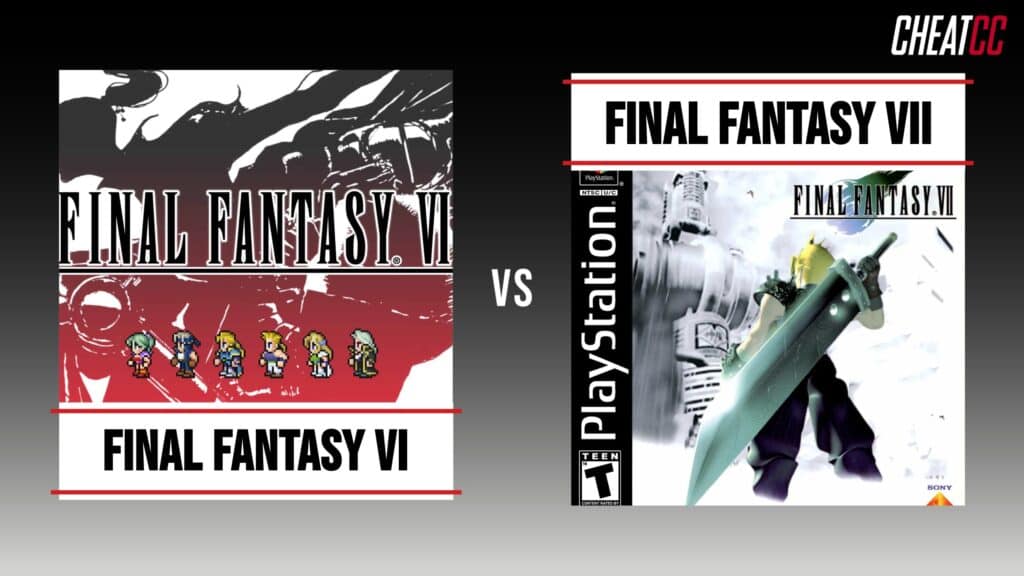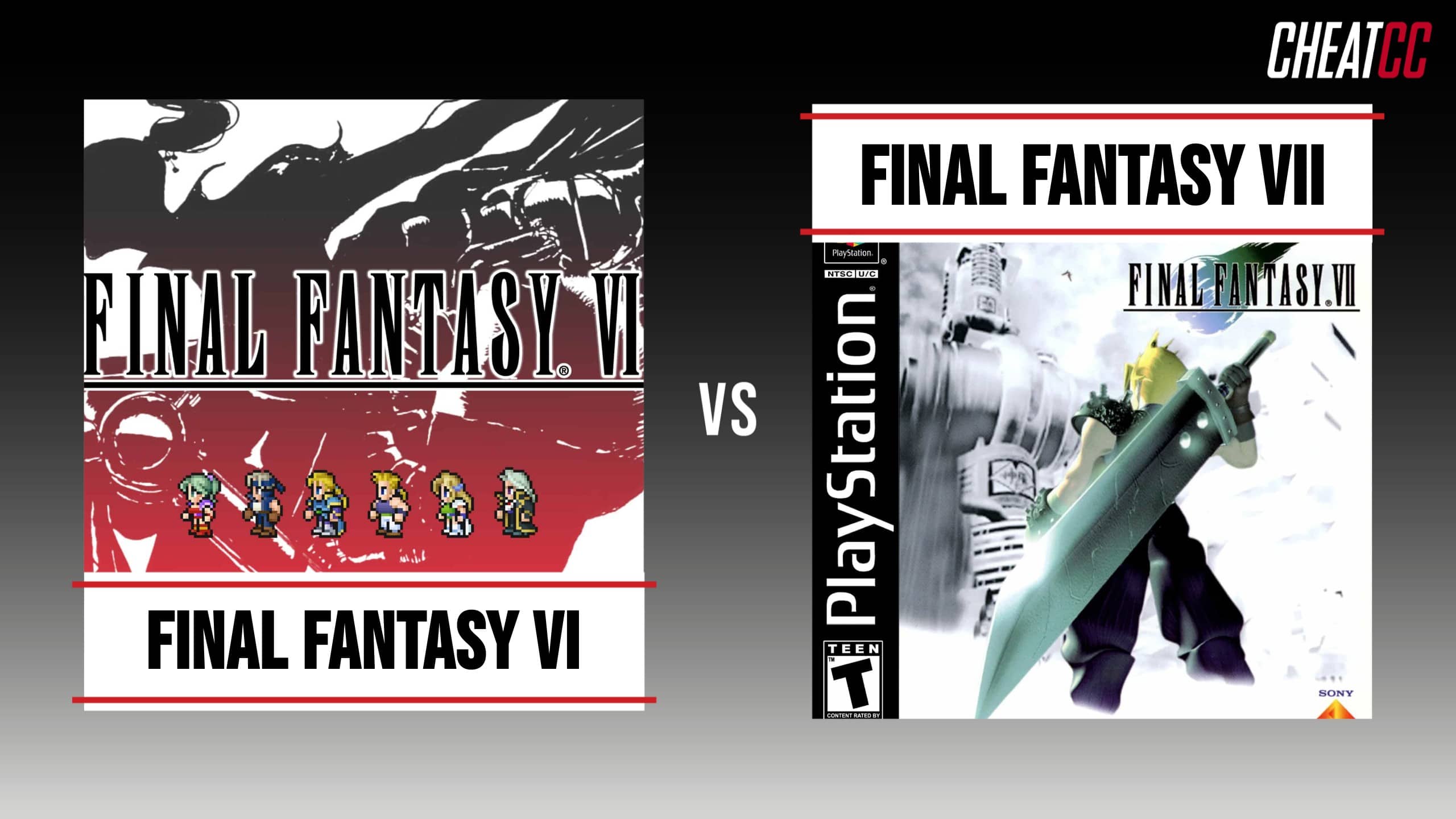Since the initial sequel’s arrival in 1988, the Final Fantasy series continues to be subject to debate among fans regarding the best entries in the franchise. Especially considering that each new mainline game changes up its characters, conflict, setting, and mechanics, there’s a lot to discuss when it comes to the criteria that make up the best games in the series. Additionally, each new mainline game tends to feature something for fans to latch onto that helps separate it from previous and subsequent entries. That said, some standouts regularly appear on the “best of” lists of players and critics alike, and the battle of Final Fantasy VI vs Final Fantasy VII for the “best” game in the series is hard to call for longtime fans.
Interestingly, both titles represent the “before and after” of a massive paradigm shift within the series. Final Fantasy VI is the last game to release on the SNES and the final exclusive Square would release for Nintendo before partnering with Sony. Similarly, Final Fantasy VII is the first 3D game in the series, the first title in a long and fruitful partnership between Square and Sony, and the game that would inevitably help the Final Fantasy series achieve mainstream success. Both titles also happen to feature some of the best gameplay and story in the entirety of the franchise, making both games clear contenders on any given day for both “Best Final Fantasy Game” and “Best JRPG”, period.
Final Fantasy VI vs Final Fantasy VII: Side-by-Side Comparison

While Final Fantasy VI represents the peak of the series’ 2D era, the next game in the series would chart bold new territory for the franchise and bring Final Fantasy into the third dimension. Further, Final Fantasy VII would end up being the first game in the series to fully embrace a futuristic, dystopian setting to sit alongside the more traditional high fantasy of the franchise’s origins. As a result of these changes, and due to it being one of the killer apps exclusive to the Sony PlayStation, Final Fantasy VII would go on to become the most successful Final Fantasy game by a large margin and help introduce the series to a much wider audience.
| Characteristic | Final Fantasy VI | Final Fantasy VII |
|---|---|---|
| Release Year | 1994 | 1997 |
| Release Platform | Super Famicom/SNES | Sony PlayStation |
| Director | Yoshinori Kitase Hiroyuki Ito | Yoshinori Kitase |
| Producer | Hironobu Sakaguchi | Hironobu Sakaguchi |
| Review Aggregate Score | 94% | 92% |
| Total Sales | 3.42 million units | 10 million units |
| Ports, Remasters, Remakes | 1 port , 2 remasters | 2 ports, 1 remaster, 1 remake |
| Graphic Style | 2D Pixel Art Sprites | 3D Polygons (Characters & Environments) |
| Combat Style | Turn-based | Turn-based |
| Series Innovations | Espers/Magicite system, “ensemble cast” approach to main character, open-world second half | First 3D game in the series, FMV cutscenes, Materia system, Limit Breaks, dystopian future setting |
| Adaptations and Sequels | N/A | Advent Children film, 4 games (Compilation of Final Fantasy VII) |
Final Fantasy VI vs Final Fantasy VII: 5 Must-Know Facts
Here are 5 must-know facts about Final Fantasy VI and Final Fantasy VII:
- Current Final Fantasy brand manager and Square Enix VP Yoshinori Kitase would get his first turn as a director for the series with Final Fantasy VI. The success of that game would eventually make way for him to direct Final Fantasy VII as well, meaning Kitase holds the distinction of guiding the Final Fantasy series from its origins into the modern era.
- While Final Fantasy VI would sell incredibly well for a JRPG on the SNES, its commercial success pales in comparison to that of Final Fantasy VII. The original PS1 release of Final Fantasy VII has sold more than 10 million units, with more than 14 million copies in total including the various ports and remasters.
- The story of Final Fantasy VI is one of the most beloved in the entire series, but it is essentially a “one-and-done” affair within the confines of the game. In contrast, Final Fantasy VII would go on to spawn an animated feature film as well as several different spin-off games that each take place within its universe.
- The transition between Final Fantasy VI and Final Fantasy VII is the turning point between the series’ beginnings and the modern era. Additionally, Final Fantasy VII‘s development and release would see Square shift its alliances and strategic partnerships from Nintendo over to Sony and its PlayStation console, resulting in one of the best libraries of PS1 titles from any single developer.
- The strength and resonance of Final Fantasy VII‘s story and characters continues to separate it from other games in the series, with Cloud and his companions ranking as some of the most recognizable and well-loved characters across the entire franchise.
Final Fantasy VI vs Final Fantasy VII: Sales and Reception
Though Final Fantasy VI slightly edges out a victory over Final Fantasy VII in terms of its review aggregate score, the same doesn’t hold true when comparing both games’ commercial sales. Final Fantasy VI would greatly outsell its predecessor and go on to be the 12th best-selling game on the SNES. However, the total sales of the original PS1 release of Final Fantasy VII positively dwarf those of Final Fantasy VI. Final Fantasy VI would eventually reach nearly 3.5 million units across both Japan and North America, but Final Fantasy VII holds cumulative sales of just over 10 million units. Further, Final Fantasy VII would end up being many players’ first foray into the franchise thanks to an excellent marketing campaign and the game’s PlayStation exclusivity would be a determining factor in boosting console sales.
Final Fantasy VI vs Final Fantasy VII: Extended Universe
The tale of Terra and her companions trying to prevent another war over magic is one of the best stories of any Final Fantasy game, featuring what is arguably the best antagonist in the entire series. Unfortunately, though, Final Fantasy VI is the only chapter of that saga that fans get to see, with no adaptations or sequel games existing to flesh out the story and its characters. Conversely, Final Fantasy VII has the most robust extended universe of any game in the Final Fantasy series. In addition to the Final Fantasy VII: Advent Children animated film, there are 4 spin-off games set in its universe as well as a new trilogy of games reimagining the events of the original in an alternate timeline. Comparatively, Final Fantasy VII is practically its own franchise.
Final Fantasy VI vs Final Fantasy VII: Beginning a New Era
Final Fantasy VII marks the series’ first foray into 3D as well as the first game in the series to adopt a more futuristic setting and conflict. That said, the game doesn’t age as gracefully as some of its sequels, with Final Fantasy VII‘s initial attempts at 3D graphics not faring as well as the subsequent leaps in technology on display in Final Fantasy VII and IX. Final Fantasy VI, though, is the opposite, showcasing the culmination of 6 games’ worth of design sensibility to be the peak of the franchise’s 2D era. As a result, Final Fantasy VI continues to age much more gracefully thanks to its timeless 2D-pixel art sprites and incredible utilization of the SNES’ hardware.
Final Fantasy VI vs Final Fantasy VII: The Importance of Heroes
One aspect that continues to set Final Fantasy VI apart from the games arriving both before and after it is its approach to the idea of a “main character”. Each Final Fantasy game typically features a main character who sees their friends and allies accompany them on a world-saving mission to stop a larger-than-life antagonist. Where Final Fantasy VI deviates, though, is in its use of an “ensemble cast” rather than a singular main character for players to attach to. The game starts with Terra as the protagonist, but eventually perspective shifts to Locke, Edgar, Celes, and Sabin to grant each of them a rightful claim to the title of Final Fantasy VI‘s “main character”. The result is that the game has one of the strongest casts of any entry in the series, but at the cost of a protagonist players can truly connect with.
Conversely, Final Fantasy VII features one of the most recognizable and iconic heroes in all of gaming in Cloud Strife. Beyond his incredible design from Tetsuya Nomura, Cloud is a character whose struggles are instantly relatable for players. Cloud refuses to come to grips with his own identity, and his inability to trust in or rely upon others stems from tragic experiences that teach him it’s best to be alone. It’s because of these flaws that Cloud is one of the series’ best characters.
Bottom Line
Any longtime fan of the Final Fantasy series will likely have a hard time ranking all 16 mainline entries. Any such list will likely change from day to day and evolve as players get older and come to glean something new from every subsequent playthrough of a classic Final Fantasy game. Despite this, Final Fantasy VI and Final Fantasy VII continue to have enough staying power for both titles to regularly land on fans’ and critics’ “Best Of” lists, which makes choosing between the two of them especially tough. Ultimately, it comes down to comparing the disparate elements of each and deciding whether one prefers the series’ 2D era or its 3D one.
There’s no denying that Final Fantasy VII is the series’ most popular game, with characters and a central conflict that continue to reverberate among new players who are just now experiencing the title for the first time. Still, Final Fantasy VI is the game that even makes Final Fantasy VII possible, and it also happens to be the first title in the series to feature direction from Yoshinori Kitase. Thanks to the fact that it represents the culmination of the series’ first several years, and thanks to its pitch-perfect JRPG gameplay and timeless presentation, the honor of “best game in the Final Fantasy series” has to go to Final Fantasy VI.
